2018 AHP Salary Report: By the Numbers
Jasmine Jones
Published: 02/14/2019
What is the Salary Report?
The AHP Salary Report examines salary levels in the United States and Canada for 21 career categories in the field of health care philanthropy. The survey measured several factors influencing pay, including individual characteristics (work, age, gender,
education level, professional designations, number of years in the field, number of people supervised) and organization characteristics (staffed beds, type of institution, number of full-time equivalent staff). New to the 2018 survey is the addition
of employee perceptions, including challenges, satisfaction levels and priorities in the workplace.
Here are a few highlights of the 2018 report, released on January 8, 2019:

How did salaries and benefits compare?
Similar to past findings, participants who reported a higher-level position, higher education level, having a professional designation and living in an urban or suburban area reported higher salaries. To better understand how respondents feel about their
salary in comparison to others at their organization, they were asked to indicate how comparable they feel their salary is with other employees at the same level. In the U.S. and Canada, about half of respondents (45 percent and 43 percent respectively)
felt their salary was comparable to other employees at their level. However, about one-third of respondents (29 percent and 37 percent respectively) felt their salary was lower.
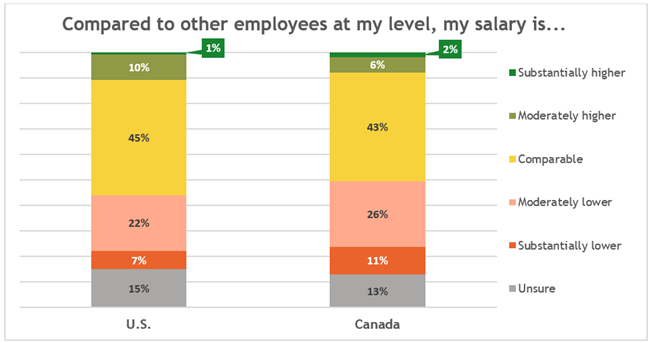
Another notable difference arises when we consider who received an increase in their salary from 2017 to 2018. About a fifth of U.S. respondents (20 percent) and a third of Canadian respondents (29 percent) either did not receive an increase in their
base salary or were unsure. For those respondents who did receive an increase, the top reasons were for meeting individual and organizational performance measures and to keep up with the cost of living.
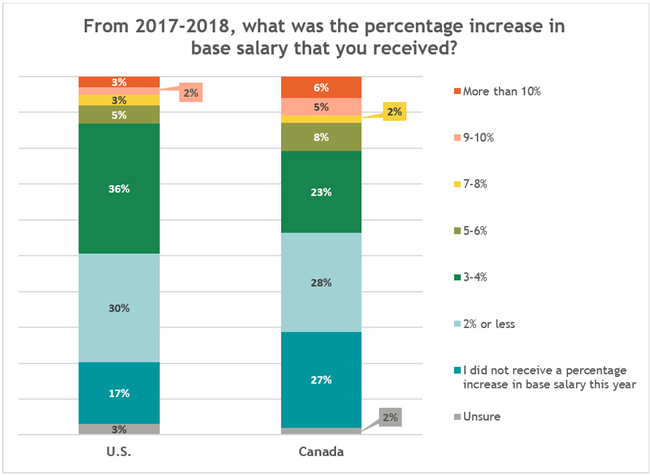
Respondents were also asked if they were eligible to receive an incentive or bonus award in 2017. Although about half of respondents are currently eligible for an incentive/bonus award (55 percent in the U.S. and 42 percent in Canada), over half of all
respondents did not receive an incentive/bonus award in 2017 (54 percent in the U.S. and 52 percent in Canada). Those who did receive an incentive/bonus award had more years of experience in the field. Additionally, those who had nine or more years
of experience were more likely to report higher percent increases in salary than their colleagues with less experience.
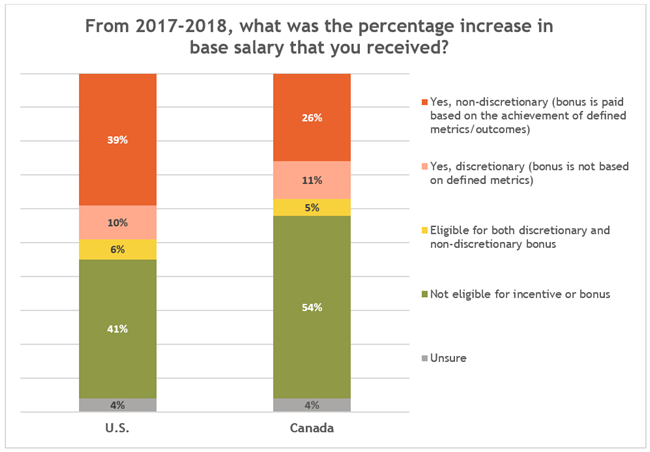
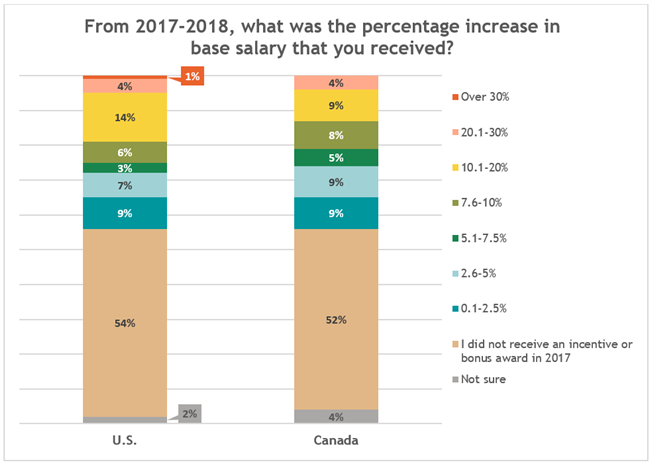
Why pick a job in this field?
In general, respondents were very satisfied working in health care philanthropy. To better understand which features drive interest in employment at a particular institution/organization, respondents were asked to rank several features according to their
level of importance. The ranking of these items was consistent in both the U.S. and Canada.
1. Cash compensation (salary plus any bonuses)
2. Paid time off
3. Flexible working hours
4. Opportunities for professional development/education
5. Ability to work from home
In addition, respondents were asked to identify the three primary reasons they had stayed at their current place of employment. Consistent in both countries, finding joy and meaning in their work was the top reason – 56 percent in the U.S. and 62
percent in Canada. Compensation was also an important factor at 41 percent in the U.S. and 31 percent in Canada. In general, respondents in the U.S. placed more importance (23 percent) on flexibility of work schedule, while Canadian respondents found
work environment more important (31 percent).
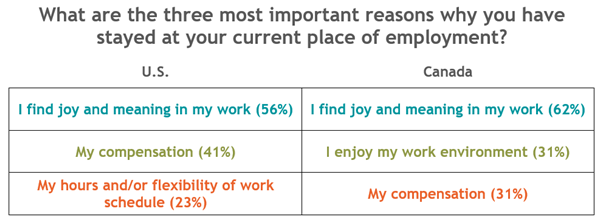
Respondents were also asked to indicate their level of satisfaction or dissatisfaction with aspects of their job. Some of the items that received a ranking of “very satisfied” or “somewhat satisfied” were similar for both the U.S.
and Canada. U.S. respondents were more satisfied with their benefits at 89 percent, and Canadian respondents were more satisfied with the level of joy and meaning found in their jobs at 95 percent.
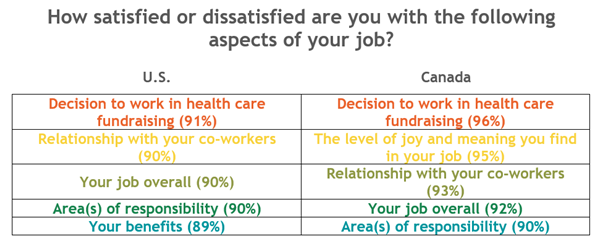
What could improve?
In addition to the areas in the field that employees are the most content with, identifying opportunities for potential growth are just as important. Continuing with satisfaction level statements, both U.S. and Canadian respondents had the highest combined
ratings for “Not very satisfied” or “Not at all satisfied” in their opportunity for growth, recognition in the work they do, amount of authority they have, their compensation and their relationships with direct supervisors.
Although each percentage is different, it is a unique trend to note that both sets of respondents were dissatisfied with the same aspects of their jobs.
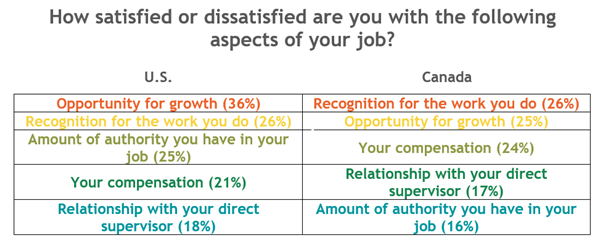
Respondents were also asked about the challenges they faced when first entering health care philanthropy. Establishing relationships with trusted partners, lack of experience and lack of a peer network were consistent for both U.S. and Canadian respondents.
Differences occurred with demonstrating qualifications in the U.S. and building a customer base in Canada. Some of these items can be expected of any employee who is first entering the field, but the consistency across both groups demonstrates the
items that should be given some extra care when applying these report results to a team dynamic.

What does this all mean?
Based on the high-level results from this report, we learn that a majority of employees in health care philanthropy are pleased with the work they do. They find joy and meaning in their work, are content with their decision to work in the field and feel
fulfilled from their job overall. Although they are satisfied with their area(s) of responsibility, some feel the opposite about the amount of authority they have and the recognition they receive for that work.
For both the U.S. and Canada, compensation was ranked one of the top three most important reasons to stay at their current place of employment. However, compensation also had one of the highest dissatisfaction ratings, so it may be seen more as a necessity
than a motivator. Compensation can’t be fixed with the flip of a switch but focusing on aspects – such as helping build relationships with partners, peer networks and a customer base – that affect an early career fundraiser
can aid in their professional development.
Want to see more details in the report about salary, benefits and perceptions? This year’s report is now available on AHP’s website. Find out more about this report at http://www.ahp.org/resources-and-tools/salary-reports.
If you have any questions about this report or the other research projects by AHP, email AHP’s Research Specialist Jasmine Jones at jasmine@ahp.org.
On-demand Learning Hub
Explore all our resources on this and many other topics in the On-demand Learning Hub